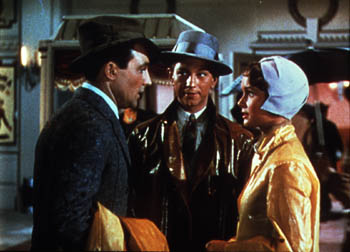![[Metroactive Movies]](/movies/gifs/movies468.gif)
[ Movies Index | Show Times | Silicon Valley | Metroactive Home | Archives ]
Water Music
'Singin' in the Rain' turns a lively, effortless 50 in a new print at the Stanford Theater
By Richard von Busack
THE FIRST TIME I heard the song "Singin' in the Rain" was in A Clockwork Orange, when Alex and his droogs yowl it as they put the boot to some victim. Such was the strength of Stanley Kubrick's desire to foul that musical--and the Hollywood it stood for--that it took me a dozen viewings of the film Singin' in the Rain to keep from envisioning futuristic yobs in jumpsuits. If, like Kubrick, some people think of Singin' in the Rain as a stiff MGM classic, they're also mistaken. In a new print with digital sound at Palo Alto's Stanford Theater, Stanley Donen and Gene Kelly's 1952 musical is ready to be loved by a new generation.
Singin' in the Rain is a comedy about the advent of sound film and the troubles it caused silent-movie actors, who had been talented pantomime artists but never elocutionists. Some silent-film stars remembered the 1920s as a golden era because they never had to memorize scripts and thus had plenty of time for carousing. Don Lockwood (the sweet-on-himself Gene Kelly) is a hambone star in silent costume dramas. A young ingenue, Kathy (Debbie Reynolds), invents the idea of dubbing, thus saving the careers of Lockwood and his chum Cosmo (Donald O'Connor). All three run afoul of the film's villain, grasping leading lady Lina Lamont (Jean Hagan).
Singin' in the Rain has its cream-puff fantasy moments, such as the dream-sequence ballet near the end. Fifty feet of floating gauze are tossed about by the gusts of offscreen airplane motors, all for the purpose of unwrapping Cyd Charisse and her nine miles of legs.
Despite such instances of dated lyricism, here is a musical for persons allergic to musicals. It earns its Technicolor raptures with a hardheaded Brooklyn wise-guy script by Betty Comden and Adolph Green. Like that other perfect film about the 1920s, Some Like It Hot, Singin' in the Rain celebrates America's jazz-age exuberance.
The film is also a comedy about certain types who have never gone out of style. Modern versions abound of Madge Blake's obsequious gossip columnist, with her gushing comment about a couple of actors at a premiere: "They've been married two months already, but they're still as happy as newlyweds." Lamont, the blonde shrew, has a dozen granddaughters plying the starlet's trade today. Lamont's famous faux-humble address to her fans is never to be forgotten: "If we bring a little joy into your humdrum lives, we feel that all our hard work ain't been in vain for nuthin'."
Like one of the first Hollywood movie musicals, The Broadway Melody (1929), Singin' in the Rain is a backstage story. The film is built almost entirely out of 1930s recycled tunes, co-written by producer Arthur Freed. The title number debuted in The Hollywood Revue of 1929, performed by the ukulele wizard Cliff Edwards and a line of chorus girls in yellow rain sou'westers. The Broadway Melody's sequel, Broadway Melody of 1936, was the source of Singin' in the Rain's "Broadway Rhythm"; it also features an ambitious rainy-day dance performed by Eleanor Powell that looks far more technically difficult than Kelly's famed routine. She tromps through sometimes calf-deep puddles, swinging partner George Murphy with her.
The Kelly number wasn't easy, though. Clive Hirschorn's biography of Kelly says that the dancer did his version with a fever of 103, while trying to coordinate the tapping of the umbrella with the beats of the music. Though the backdrop looks like a sound stage, the scene was filmed outdoors. Since the budget was too small for the overtime required for a night shoot, Kelly and Donen shot in daylight, with tarps blocking the sun.
When you see the Powell/Murphy number, it looks like hard work, performers trying to wow you. But Kelly's dance is better remembered because of its illusion of simplicity--of an artificial kind of a guy suddenly finding something spontaneous in himself.
What's missing in current musicals is both that simplicity and confidence--who'd call a nervous musical like Moulin Rouge! simple or self-confident? If the future of the movie musical is, essentially, in its past, what ought to be borrowed from Singing' in the Rain is its wised-up attitude toward the making of entertainment. Too often, nouveau musicals resemble the pre-sound Lockwood, with his smarmy insistence on "dignity, always dignity."
[ Silicon Valley | Metroactive Home | Archives ]
![]()

Hat's Entertainment: Gene Kelly (left), Donald O'Connor and Debbie Reynolds tackle the coming of Hollywood sound in 'Singin' in the Rain.'
Singin' in the Rain (1952), starring Gene Kelly, Donald O'Connor and Debbie Reynolds, plays Dec. 6-15 at the Stanford Theater in Palo Alto.
Send a letter to the editor about this story to letters@metronews.com.
From the December 5-11, 2002 issue of Metro, Silicon Valley's Weekly Newspaper.